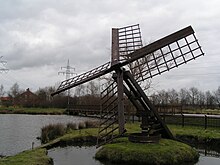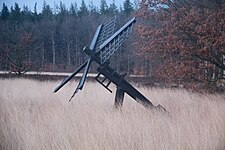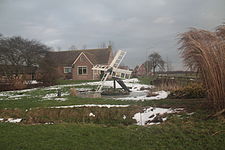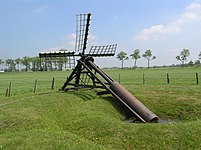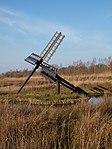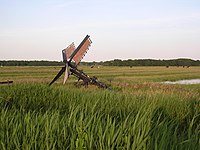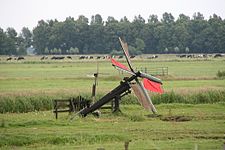Flutter mill


The flutter mill or the flutter , derived from fries. Fletta = to move (ndl. Tjasker ), is the simplest and smallest type of windmill and is used for vertical water transport and drainage .
The mill was invented in Holland in the 16th century , where it was used for poldering and in East Friesland for draining wetlands, and by the middle of the 20th century it had almost disappeared due to modern pumping stations. Today in northern Germany there are again a handful in museums and in use for re- humidifying biotopes . There are still 14 of these mills in North Holland and eleven in Friesland .
The flutter essentially consists of an Archimedean screw and a smaller wind wing cross (1.5–7 m diameter) with board or sail gate wings (see there). This sits directly at the upper end of the Archimedean screw; directly at the corrugating head behind the wings supporting a small block at an angle of about 30 ° the entire device. The lower end of the Archimedean screw protrudes into the moat from which the water is to be lifted and directed to the outside. It is turned into the wind by hand . Because they were small and light, these mills could be easily moved when the water was pumped out of the trench or drainage was no longer necessary in a region. Today the conveying area would be referred to as a jacketed screw pump, because the trough common in screw pumps is replaced here by a jacketed pipe that is firmly attached to the helix and follows the rotation.
These mills were most common in the lowlands in East Friesland and in the Netherlands (provinces of North Holland and Friesland ).
Germany
In Germany, flutters are now in Riepe , Bedekaspel , Weenermoor and Lütjegaste in East Frisia and in Moorsee in the Wesermarsch district . The replica of a flutter mill is exhibited in the Münkeboe Village Museum.
Netherlands
In the Netherlands, Tjaskers are still widespread in the polder regions.
literature
- Albert Betz: Wind energy and its use by windmills. Vandenhoeck & Ruprecht, Göttingen 1926, today available as an unchanged reprint, Ökobuch, Staufen, ISBN 3-922964-11-7
- Leo Hopf: Mill technical internship.
- Vol. 1: Milling. Leipzig 1950.
- Vol. 2: Mill construction. Leipzig 1952
- Friedrich Kettenbach: The miller and mill builder. Practical manual for millers, mill builders and technical educational institutions, Vol. 1 and 2, Leipzig 1907/1908
- Johannes Mager: Mill wing and water wheel. Leipzig 1990, ISBN 3-343-00257-7
- Rudolf Sacher: manual of the miller and mill builder. Leipzig 1921. 2nd edition, ibid. 1924
- Werner Schnelle: Mill construction: water wheels and windmills - preserve and preserve. Berlin 1999, ISBN 3-345-00678-2 .
